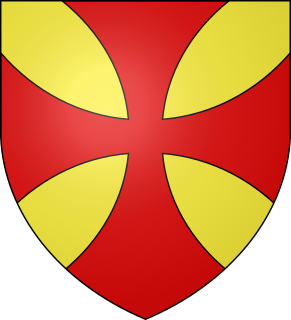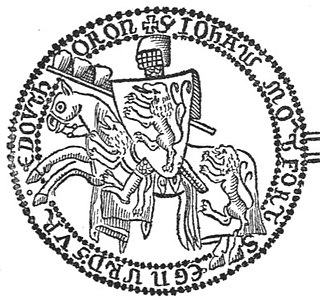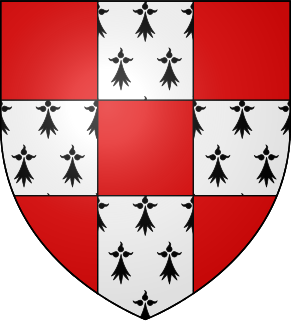Hugh III, also called Hugh of Antioch-Lusignan and the Great, was the king of Cyprus from 1267 and king of Jerusalem from 1268. Born into the family of the princes of Antioch, he effectively ruled as regent for underage kings Hugh II of Cyprus and Conrad III of Jerusalem for several years. Prevailing over the claims of his cousin Hugh of Brienne, he succeeded both young monarchs upon their deaths and appeared poised to be an effective political and military leader.

The Crusader state of the Kingdom of Jerusalem, created in 1099, was divided into a number of smaller seigneuries. According to the 13th-century jurist John of Ibelin, the four highest crown vassals in the kingdom proper were the count of Jaffa and Ascalon, the prince of Galilee, the lord of Sidon, and the lord of Oultrejordain.

Hugh IV was King of Cyprus from 31 March 1324 to his abdication, on 24 November 1358 and, nominally, King of Jerusalem, as Hugh II, until his death. The son of Guy, Constable of Cyprus, and Eschiva of Ibelin, Hugh succeeded his father as Constable of Cyprus in 1318, and later succeeded to the throne of Cyprus on the death of his uncle Henry II, since Henry II had no son. He was a member of the House of Poitiers-Lusignan.

The House of Ibelin was a noble family in the Crusader Kingdom of Jerusalem in the 12th century. They rose from humble beginnings to become one of the most important families in the kingdom, holding various high offices and with extensive holdings in the Holy Land and Cyprus. The family disappeared after the fall of the Kingdom of Cyprus in the 15th century.
Baldwin of Ibelin, also known as Baldwin II of Ramla, was an important noble of the Kingdom of Jerusalem in the 12th century and was lord of Ramla from 1169-1186. He was the second son of Barisan of Ibelin, and was the younger brother of Hugh of Ibelin and older brother of Balian of Ibelin. He first appears in the historical record as a witness to charters in 1148.
John of Ibelin, called the Old Lord of Beirut, was a powerful crusader noble in the 13th century, one of the best known representatives of the influential Ibelin family. The son of Balian of Ibelin and the dowager queen Maria Comnena, he had close ties with the nobility of both Cyprus and Jerusalem, since he was the half-brother of Queen Isabella I of Jerusalem. Before he was 20, he was appointed constable of Jerusalem, and a few years later became lord of Beirut. John rebuilt Beirut after Saladin's conquest, and established the grand Ibelin family palace. He served as regent of Jerusalem on behalf of his niece Maria of Montferrat from 1205 to 1210 after her mother, Queen Isabella, died. He was also regent for Isabella's grandson Henry I of Cyprus from 1228 until Henry came of age in 1232. John was known as a principled man, and was seen as the natural leader of the Christian barons in the Holy Land. He resisted the power-seeking of Frederick II, Holy Roman Emperor, in Cyprus, and opposed the imperial forces until King Henry came of age.
John of Ibelin, count of Jaffa and Ascalon, was a noted jurist and the author of the longest legal treatise from the Kingdom of Jerusalem. He was the son of Philip of Ibelin, bailli of the Kingdom of Cyprus, and Alice of Montbéliard, and was the nephew of John of Ibelin, the "Old Lord of Beirut". To distinguish him from his uncle and other members of the Ibelin family named John, he is sometimes called John of Jaffa.

The Principality of Galilee was one of the four major seigneuries of the crusader Kingdom of Jerusalem, according to 13th-century commentator John of Ibelin. The direct holdings of the principality centred around Tiberias, in Galilee proper, but with all its vassals, the lordship covered all Galilee and southern Phoenicia. The independent Lordship of Sidon was located between Galilee's holdings. The principality also had its own vassals: the Lordships of Beirut, Nazareth, and Haifa.

Philip Ι of Montfort, was Lord of La Ferté-Alais and Castres-en-Albigeois 1228–1270, Lord of Tyre 1246–1270, and Lord of Toron aft. 1240–1270. He was the son of Guy of Montfort and Helvis of Ibelin.
John of Ibelin, often called John II, was the Lord of Beirut from 1254, named after his grandfather John I, the famous "Old Lord of Beirut". His parents were Balian of Ibelin and Eschiva, daughter of Walter of Montbéliard and Burgundia of Cyprus.
Guy of Ibelin, of the Ibelin family, was count of Jaffa and Ascalon during the latter part of the Crusades. He was the son of John of Ibelin and Maria of Barbaron. He was count in name only. His father, John of Jaffa, had died in 1266, after which the fragile truce with the Muslims collapsed, and Jaffa was captured by Baibars in 1268. John was probably succeeded by Guy's older brother James, who held the title of Count of Jaffa until his death in 1276, at which point the title passed to Guy.

John of Montfort was lord of Toron from 1257 to 1266 and Lord of Tyre from 1270 to 1283. He was the son of Philip of Montfort, and his second wife Maria of Antioch-Armenia.
Eschive d'Ibelin (1253–1312) was suo jure Lady of Beirut in 1282–1312. She was the daughter of John II of Beirut, lord of Beirut, and of Alice de la Roche, and a member of the influential Ibelin family.
Isabella of Ibelin (1252–1282) was lady of Beirut from 1264 until her death in 1282, and also held the title of Queen of Cyprus. She was the daughter of John II of Beirut, lord of Beirut, and of Alice de la Roche sur Ognon.
Isabella of Ibelin (1241–1324) was queen of Cyprus and Jerusalem by marriage to Hugh III of Cyprus.
Rupen of Montfort was a Cypriot nobleman, the second surviving son of Humphrey of Montfort and Eschive d'Ibelin.

Alice de la Roche, Lady of Beirut, Regent of Beirut was the wife of John II, Lord of Beirut in the Kingdom of Jerusalem. She was a daughter of Guy I, Lord of Athens. Alice is sometimes referred to as Alice of Athens. Alice was regent of Beirut for her daughter, Lady Isabella, while Isabella was the queen consort of Cyprus.
Helvis of Ibelin was a daughter of Balian of Ibelin and his wife, Maria Komnene, who was the dowager Queen of Jerusalem. Helvis was a member of the House of Ibelin. She was Lady of Sidon by her first and second marriage.
Margaret of Antioch-Lusignan, also known as Margaret of Tyre, was an Outremer noblewoman who ruled the Lordship of Tyre in the Kingdom of Jerusalem. A member of the House of Antioch-Lusignan, she married John of Montfort, Lord of Tyre, and was granted rule of the city as widow in 1284. She concluded a truce with the Egyptian sultan Al-Mansur Qalawun and ruled until 1291, when she ceded the lordship and moved to Cyprus.
The Lordship of Tyre was a semi-independent domain in the Kingdom of Jerusalem from 1246 to 1291.






